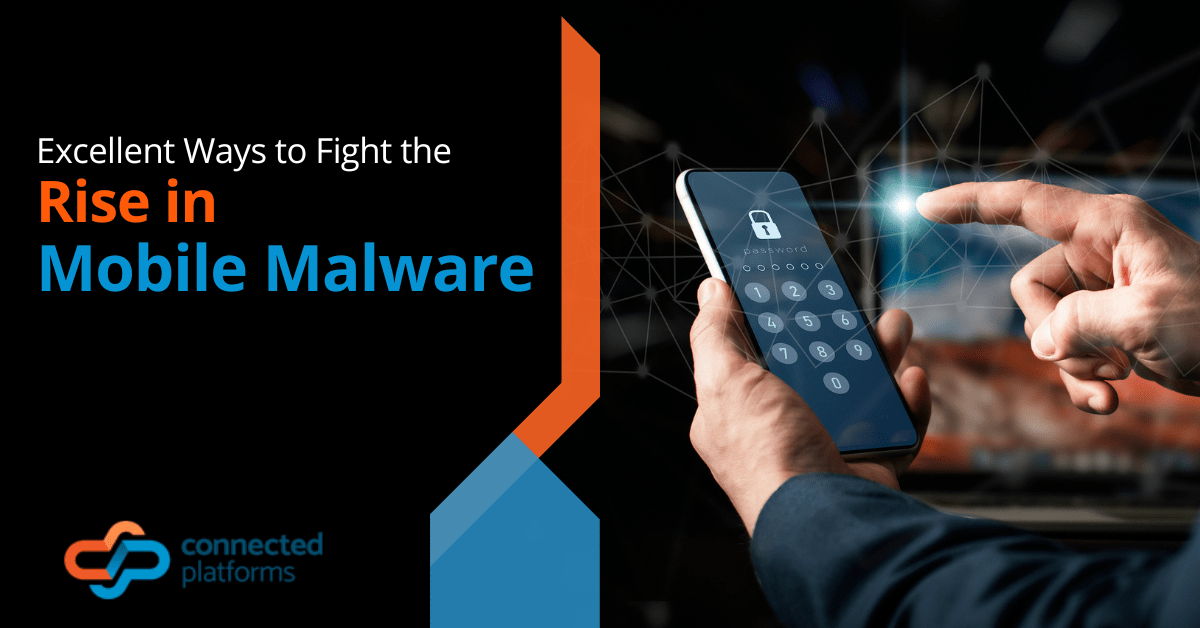It’s no surprise that mobile malware attacks are on the rise. In the modern world, many of us are glued to our phones – both for work and leisure purposes. Cybercriminals know this, and they are pivoting their attack tactics to focus on exploiting our mobile devices.
Below, we’ll look in more detail at what mobile malware is and how to protect your organisation.
What is Mobile Malware?
Mobile malware refers to malicious pieces of code that specifically target mobile devices, such as smartphones and tablets, with the goal of either:
- Accessing and stealing private data
- Spying on the user
- Using the device as a foothold to gain access into a corporate network
- Launching a further attack, such as releasing a Trojan or deploying ransomware.
Mobile malware threats are on the rise. Research shows that mobile malware attacks have increased by 500% in recent years.
Why Are Mobile Malware Attacks Becoming More Prevalent?
Mobile malware is becoming more popular for a number of reasons. Firstly, there’s the fact that nearly everyone uses a mobile phone today in America. On top of this, with the rise of hybrid and mobile work, it’s increasingly common for people to use either their own phones or company phones for work activities. This, in turn, means our phones are more likely to hold sensitive data that cybercriminals want to get their hands on.
On top of this, it’s a well-known fact among security professionals that mobile phones are less robust in terms of security than laptops or computers. They tend to have less protections, making them easier to hack and break into.
Then, there’s the rise in mobile applications: consumer and business apps we use for things like shopping, email, banking and much more. These apps often contain lucrative data that cybercriminals can exploit or sell on.
How Do Mobile Malware Attacks Happen?
There are numerous forms of mobile malware attacks that businesses and individuals must defend against. The major threats are:
- Fake malicious applications: One of the sneakiest ways attackers manage to riddle phones with malware is by creating fake applications that they then deploy on popular app stores. Often, these apps will imitate well-known apps, luring users to download them thinking they’re legitimate. However, when the user downloads the app, they will inadvertently release malware onto their device without knowing it. While Apple and Google spend a lot of money on discovering and removing malicious apps from the app store, some malicious apps still manage to go unnoticed.
- Social engineering: SMS-ishing and instant message social engineering attacks are another way hackers manage to trick mobile users into downloading mobile malware. In a social engineering attack, a hacker will pose as a well-known brand or body. The message will include a link to an application or internet page, which either harvests the users sensitive data or deploys a malware variant.
- Man in the middle attacks: Hackers can often exploit mobile phones when they connect to unsecured WiFi networks. These networks are easy for hackers to break into with a little code. From there, they can snoop on all communications that happen on the network and launch further mobile-focused attacks.
How Do I Know If My Phone Has Been Compromised?
This is the other unfortunate issue with mobile malware. Unfortunately, victims often don’t know they’ve been hacked until it’s too late. Mobile malware tends to be silent but lethal, working in the background of a device, leaching sensitive data or waiting until the prime opportunity to show itself and launch an attack.
For organisations, these attacks can have huge implications. Data breaches and cyber-attacks can trigger compliance fines, lost revenue and eroded consumer trust. It’s vital that companies take a proactive stance to mitigating the mobile malware threat.
Protecting You and Your Company From Mobile Malware
The good news is that, with the right tools and education, you can reduce the likelihood of mobile malware harming your company. Here’s what to do:
- Educate your users on social engineering attacks, including SMS-ishing
- For corporate devices, deploy mobile device management (MDM)
- Create a mobile device usage policy, including guidelines that users should never download unknown or unauthorised applications. Also remind users not to connect to unknown or public WiFi spots.
- Boost mobile security by mandating multi-factor authentication for all corporate applications
- Create a process for employees to report attempted SMS-ishing attacks, so you can alert other users
- Automate the application and hardware device update process. These updates contain critical security patches that prevent malware attacks.
We’ll Help You Prevent Mobile Malware Attacks And Boost Your Security Posture!
Safeguarding mobile devices is critical to keeping your company safe from hackers. Managed IT from Connected Platforms lets you stop worrying about your mobile security and allows you to focus on what you do best – growing your business.
For managed IT services Brisbane wide, call us on (07) 3062 6932 or book an obligation-free coffee meeting with Eric to learn more about how we can help to take the hassle out of cybersecurity in your business.




